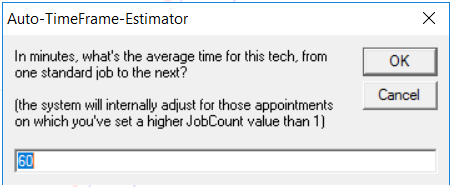ServiceDesk - auto-timeframe-estimator
A feature called the Auto-TimeFrame-Estimator can be accessed via the DispatchMap. This is useful for operations that initially schedule customers for all-day appointments. These operations usually plan each day's jobs the evening before, using the DispatchMap to arrange the jobs efficiently without any time restrictions.
After arranging the jobs, they can give customers a specific time frame. Clients asked for a way to automate this process, even automatically adding estimated times. If necessary, you may repeat the process (i.e., you added a job to the roster and needed to optimize it once more).
This feature automatically adds time frames to a technician's appointments based on your settings (like time frame length, average travel time, and so on). Since it's easier to predict when the technician will arrive at the first appointment, some companies prefer to give these customers a shorter time frame (like an hour or even 30 minutes). The Auto-TimeFrame-Estimator supports this.
If your operation begins with all-day schedules and then refines them on the previous day, we strongly suggest using this approach. It significantly reduces effort.
Using the auto-timeframe-estimator
To use it,
Open the DispatchMap by pressing (F5)
Ctrl-Click on any tech's name above their list of jobs.
Using minutes, enter the average time for a standard job.
Enter the time for the first appointment.
Using whole hours, enter the size of the time frames.
Using minutes, enter the size of the time frame for the first appointment.
Review then confirm the proposed time frames.
A few considerations
The system now stores each tech's preferred settings, eliminating the need to re-enter them each time
The auto-timeframe-estimator rounds off each timing to the nearest full hour. There is an option to have it round to the nearest half-hour instead. To invoke the option, bring up your DispatchMap's CheatSheet (right-click in any non-operative space) and pick this option:
As a result, we are now able to produce something like this:
For a more enhanced automation method, we invite you to explore our Graphhopper route optimization.








